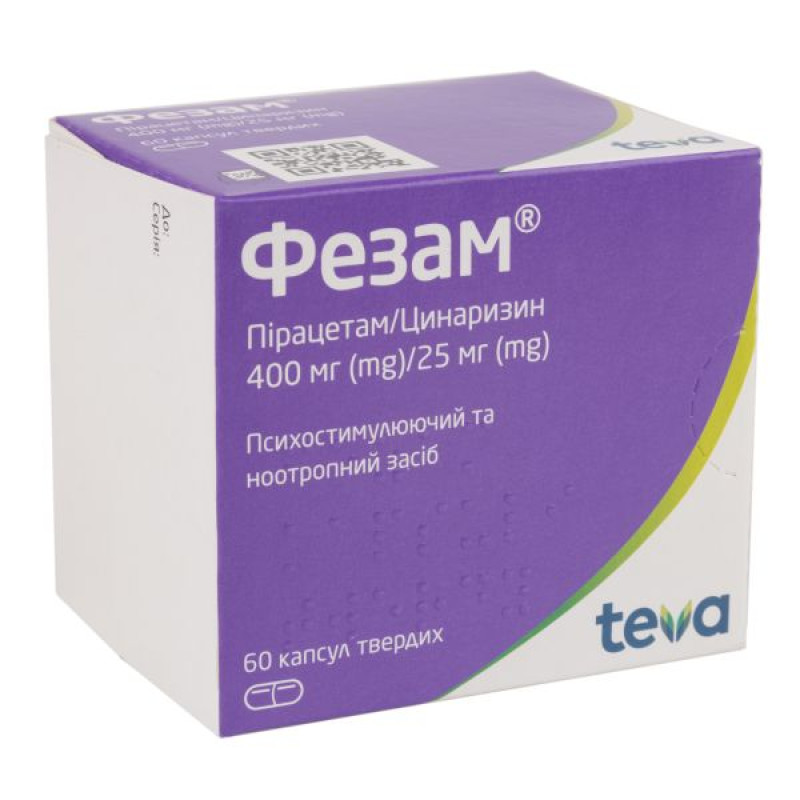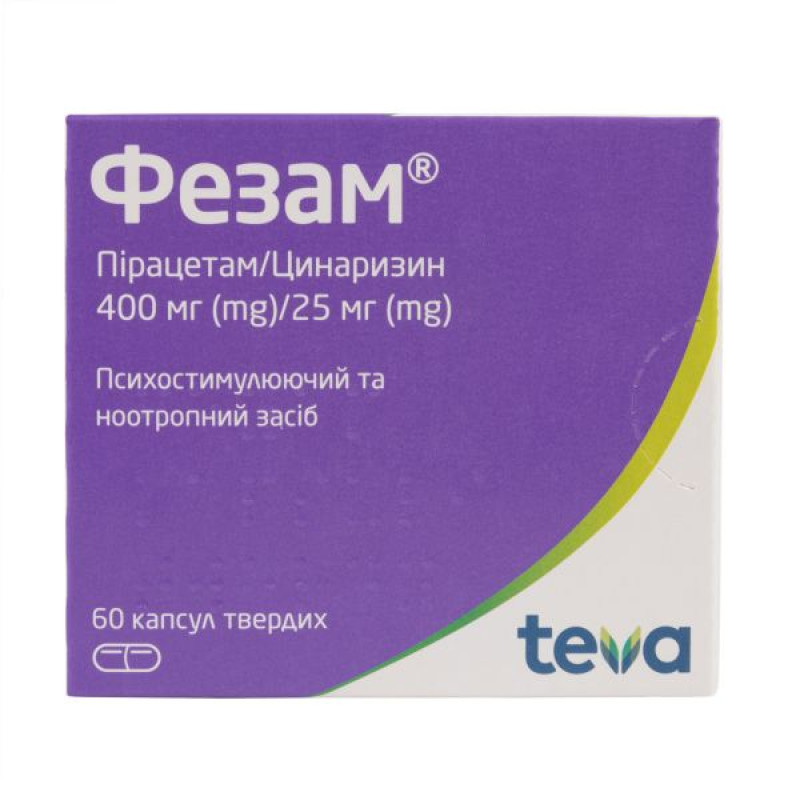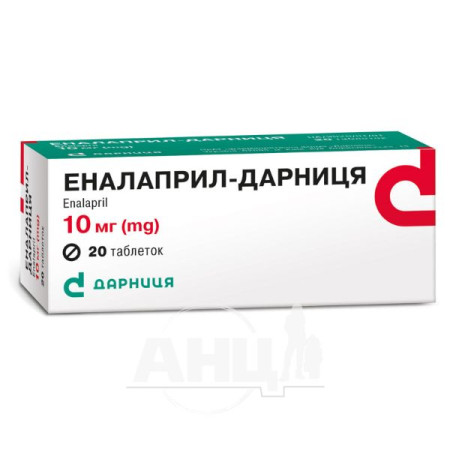Phezam capsules No. 60

Instructions for Phezam capsules No. 60
Composition
active ingredients: 1 capsule contains piracetam 400 mg, cinnarizine 25 mg;
excipients: lactose monohydrate, colloidal anhydrous silica, magnesium stearate, hard gelatin capsules: gelatin, titanium dioxide (E 171).
Dosage form
The capsules are hard.
Main physicochemical properties: hard, cylindrical gelatin capsules of white color, filled with a powdery mixture of white or pale cream color, the presence of agglomerates is allowed.
Pharmacotherapeutic group
Psychostimulants and nootropics.
ATX code N06B X.
Pharmacological properties
Pharmacodynamics.
Phezam® is a combination drug. The active components of the drug are piracetam, a cyclic derivative of γ-aminobutyric acid, and cinnarizine, a selective calcium channel blocker.
Piracetam is a nootropic that acts on the brain, improving cognitive functions such as learning ability, memory, attention, and mental performance. There are probably several mechanisms of action of the drug on the central nervous system: changing the speed of propagation of excitation in the brain; enhancing metabolic processes in nerve cells; improving microcirculation by influencing the rheological characteristics of the blood, without causing a vasodilator effect. Improves connections between the cerebral hemispheres and synaptic conduction in neocortical structures. After prolonged use of the drug, patients with decreased brain function show improvement in cognitive functions and improved attention.
Cinnarizine inhibits the contraction of vascular smooth muscle cells by blocking calcium channels. In addition to direct calcium antagonism, cinnarizine reduces the contractile effect of vasoactive substances such as norepinephrine and serotonin by blocking the calcium channel receptors controlled by them. The blockade of calcium entry into cells depends on the type of tissue, resulting in antivasoconstrictor effects without affecting blood pressure and heart rate. Cinnarizine can further improve inadequate microcirculation by increasing the elasticity of the erythrocyte membrane and reducing blood viscosity. Cellular resistance to hypoxia increases. Cinnarizine inhibits stimulation of the vestibular system, which results in the suppression of nystagmus and other autonomic disorders. Cinnarizine prevents the occurrence of acute attacks of dizziness.
Pharmacokinetics.
The drug is rapidly and completely absorbed from the gastrointestinal tract. Cinnarizine reaches peak plasma concentrations one hour after oral administration. It is completely metabolized. It is 91% bound to blood proteins. 60% is excreted unchanged in the feces, the remaining amount is excreted in the urine as metabolites.
The maximum plasma concentration of piracetam is reached after 2-6 hours. Piracetam freely penetrates the blood-brain barrier and is excreted unchanged in the urine.
Indication
Chronic and latent cerebral circulatory insufficiency in atherosclerosis and arterial hypertension; angiodystonic ischemic stroke and condition after stroke.
Post-traumatic cerebrasthenia.
Encephalopathy of various origins.
Psychoorganic syndrome with a predominance of memory impairment and other cognitive functions.
Labyrinthopathy – dizziness, tinnitus, nausea, vomiting, nystagmus.
Meniere's syndrome.
Prevention of motion sickness.
Contraindication
Hypersensitivity to piracetam, cinnarizine or any auxiliary component of the drug; individual sensitivity to pyrrolidone derivatives.
Severe renal failure, acute cerebrovascular accident (hemorrhagic stroke), Huntington's chorea, parkinsonism, increased intraocular pressure; psychomotor agitation.
Pregnancy or breastfeeding.
Interaction with other medicinal products and other types of interactions
The simultaneous use of alcohol and drugs that depress the central nervous system (CNS), tricyclic antidepressants, increases their sedative effect.
The drug potentiates the effect of nootropic, antihypertensive and vasodilator drugs. Use together with vasodilator drugs enhances its effect, and the presence of cinnarizine reduces the activity of hypertensive drugs.
Phezam® enhances the activity of thyroid hormones and can cause tremors and restlessness.
Diagnostic intervention. Due to its antihistamine effect, cinnarizine, which is part of the drug, can mask positive reactions to skin reactivity factors during skin testing, so its use should be discontinued 4 days before it is performed.
Antiepileptic drugs. No interactions have been observed with carbamazepine, phenytoin, phenobarbital, sodium valproate (information is based on known data from the use of piracetam at a dose of 20 mg/day daily for 4 weeks).
Acenocoumarol. In patients with severe recurrent thrombosis, the use of piracetam in high doses (9.6 g/day) did not affect the dosage of acenocoumarol to achieve a prothrombin time (international normalized ratio) of 2.5-3.5, but with its simultaneous use, a significant decrease in the level of platelet aggregation, fibrinogen levels, von Willebrand factors [coagulation activity (VIII: C); ristocetin cofactor (VIII: vW: Rco) and plasma protein (VIII: vW: Ag)], blood viscosity and blood plasma was noted.
Pharmacokinetic interactions
The likelihood of changes in the pharmacodynamics of piracetam under the influence of other drugs is low, since 90% of piracetam is excreted unchanged in the urine.
In vitro, piracetam does not inhibit cytochrome P450 isoforms CYP1A2, 2B6, 2C8, 2C9, 2C19, 2D6, 2E1 and 4A9/11 at concentrations of 142, 426, 1422 μg/ml.
At a concentration of 1422 μg/mL, a slight inhibition of CYP2A6 (21%) and 3A4/5 (11%) was observed. However, the Ki of these two CYP isomers is sufficient above 1422 μg/mL. Therefore, metabolic interactions with drugs metabolized by these enzymes are unlikely.
Application features
Renal insufficiency. The drug should be administered with caution to patients with renal disease. In cases of mild or moderate renal insufficiency, it is recommended to reduce the therapeutic dose or increase the interval between applications, especially if creatinine clearance is <60 ml/min.
Hepatic impairment. The drug should be administered with caution to patients with hepatic impairment. Liver enzyme values should be monitored in patients with impaired liver function.
Elderly patients. During long-term therapy in elderly patients, regular monitoring of renal function is recommended, and if necessary, the dose should be adjusted depending on creatinine clearance.
Penetrates through the filter membranes of hemodialysis machines.
The use of the drug should be avoided in porphyria.
Effect on laboratory tests. The drug may give a false-positive result during doping control in athletes, as well as when determining radioactive iodine, due to the presence of iodine-containing dyes in the capsule shell.
Effect on platelet aggregation. Due to the fact that piracetam reduces platelet aggregation, the drug should be prescribed with caution to patients with impaired hemostasis, with conditions that may be accompanied by bleeding (gastrointestinal ulcer), during major surgical operations (including dental interventions), patients with symptoms of severe bleeding or patients with a history of hemorrhagic stroke; as well as to patients taking anticoagulants, platelet antiaggregants, including low doses of acetylsalicylic acid.
Like other antihistamines, Phezam® may cause irritation in the epigastric region; its use after meals may reduce the symptoms of gastric irritation.
You should refrain from taking alcohol or antidepressants at the same time, as the drug may cause drowsiness, especially at the very beginning of treatment (see section "Interaction with other medicinal products and other types of interactions").
Excipients: This medicinal product contains lactose. Therefore, patients with rare hereditary problems of galactose intolerance, the Lapp lactase deficiency or glucose-galactose malabsorption should not take this medicinal product.
Use during pregnancy or breastfeeding
Do not use the medicine during pregnancy or breastfeeding.
If treatment with the drug is necessary, breastfeeding should be discontinued.
Ability to influence reaction speed when driving vehicles or other mechanisms
Caution should be exercised when driving or operating other machinery due to the possible occurrence of adverse reactions from the central nervous system.
Method of administration and doses
Phezam® capsules should be taken orally after meals, without chewing, with water.
Adults
1-2 capsules 3 times a day.
The course of treatment is 1-3 months, depending on the severity of the disease.
Do not use for longer than 3 months without a break! 2-3 courses per year are possible.
Children
Do not apply.
Overdose
Symptoms: increased manifestations of side effects of the drug. In isolated cases of acute overdose, dyspeptic phenomena (bloody diarrhea, abdominal pain), changes in consciousness from drowsiness to stupor and coma, vomiting, extrapyramidal symptoms, arterial hypotension were observed. In children, with overdose, excitation reactions predominate - insomnia, anxiety, euphoria, irritability, tremor, rarely - nightmares, hallucinations, convulsions.
Treatment: gastric lavage (preferably within the first hour after ingestion), use of activated charcoal. Conduct symptomatic therapy. Hemodialysis is possible.
Adverse reactions
Nervous system: hyperkinesia, ataxia, headache, sleep disturbances, insomnia, vestibular disorders, dizziness, increased frequency of epileptic seizures, balance disorders/worsening of the course of epilepsy, tremor, hypersomnia, lethargy, dyskinesia, parkinsonism, fatigue. Prolonged use in elderly patients may lead to the development of extrapyramidal phenomena.
Immune system disorders: hypersensitivity, including anaphylaxis, skin reactions.
On the part of the digestive tract: dry mouth, dyspepsia, abdominal pain, upper abdominal pain, stomach discomfort, diarrhea, cholestatic jaundice, increased salivation, nausea, vomiting.
Skin: angioedema, dermatitis, pruritus, rash, urticaria, photosensitivity, hyperhidrosis, actinic keratosis, lupus erythematosus, and lichen planus.
On the part of the psyche: increased excitability, nervousness, confusion, drowsiness, depression, anxiety, hallucinations.
Musculoskeletal system: muscle rigidity.
Others: asthenia, increased sweating, sexual arousal, hemorrhagic disorders.
With a long course of treatment, in rare cases, weight gain may occur.
Expiration date
3 years.
Storage conditions
Store at a temperature not exceeding 25 ºС in the original packaging.
Keep out of reach of children.
Packaging
10 capsules in a blister; 2 or 6 blisters in a cardboard box.
Vacation category
According to the recipe.
Producer
Balkanfarma-Dupnytsia JSC.
Location of the manufacturer and address of its place of business
3 Samokovskoe Shose St., Dupnitsa, 2600, Bulgaria.
There are no reviews for this product.
There are no reviews for this product, be the first to leave your review.
No questions about this product, be the first and ask your question.









